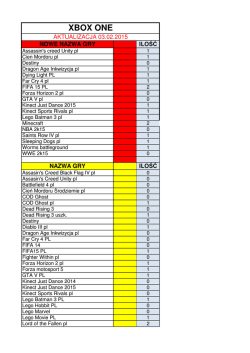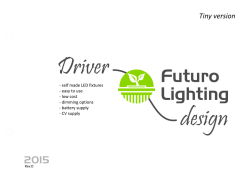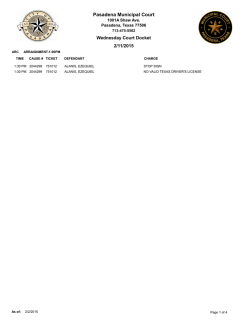
AVANCES - EDU Blogs
AVANCES EN CIENCIAS E INGENIERÍAS SECCIÓN/SECTION C ARTÍCULO/ARTICLE A new system to detect distraction and drowsiness using time of flight technology for intelligent vehicles Un nuevo sistema para detectar la distracción y la somnolencia utilizando el tiempo de tecnología de vuelo para vehículos inteligentes Marco Flores Calero1∗ , Fernando A. Guevara1,2, Oswaldo S. Valencia1,3 1 Departamento de Eléctrica y Electrónica, Universidad de las Fuerzas Armadas, ESPE. Av. Gral. Rumiñahui s/n, PBX. 171-5-231B Sangolquí (Pichincha), Ecuador. ∗ Autor principal/Corresponding author, e-mail: mjfl[email protected] Editado por/Edited by: Cesar Zambrano, Ph.D. Recibido/Received: 02/04/2014. Aceptado/Accepted: 11/09/2014. Publicado en línea/Published on Web: 19/12/2014. Impreso/Printed: 19/12/2014. Abstract Nowadays, most countries in the world suffer several traffic issues which generate public health problems such as deaths and injuries of drivers and pedestrians. In order to reduce these fatalities, a system for automatic detection of both distraction and drowsiness is presented in this research. Artificial intelligence, computer vision and time of flight (TOF) technologies are used to compute both distraction and drowsiness indexes, in real time. Several experiments have been developed in real conditions during the day, inside a real vehicle and in laboratory conditions, to prove the efficiency of the system. Keywords. Distraction, drowsiness, traffic accidents, TOF technology, intelligent vehicles. Resumen La mayoría de los países en el mundo sufren de varios problemas de tráfico que generan problemas de salud pública, tales como, excesivas muertes y lesiones de los conductores y los peatones. Con el fin de reducir estas cifras de siniestralidad, en esta investigación se presenta un sistema para la detección automática de la distracción y la somnolencia. Las tecnologías de inteligencia artificial, visión por computador y una cámara de tiempo de vuelo (TOF) son utilizadas para calcular los índices de distracción y somnolencia, en tiempo real. Varios experimentos se han desarrollado en condiciones reales durante el día, dentro de un vehículo real y en el laboratorio, para probar la eficiencia del sistema. Palabras Clave. Distracción, adormecimiento, accidentes de tráfico, tecnología TOF, vehículos inteligentes. Introduction At the present time, vehicle security research is focused on driver analysis [2, 10, 11], for this reason, the main objective is to build an intelligent system able to alert the driver about a possible road accident; this technology will increase vehicle safety, anticipating dangerous situations that may arise due to human error while driving. In particular, distraction and drowsiness are studied in depth during this research. Distraction and drowsiness appears in situations of stress and fatigue in an unexpected and inopportune way, and they may be produced by sleep disorders, certain type of medications, lack of concentration, situations of boredom, such as, driving for long periods of time. Keeping this in mind, the sensation of sleepiness and the distrac- C8 tion reduce the level of vigilance, and increases risk situations, where a road accident may occur. Driver’s distraction has caused about of 20 % of all traffic accidents [2], i.e., it has generated over 3000 deaths in the United States in 2011. On the other hand, drowsiness causes between 10% and 20% of traffic accidents resulting in both fatal accidents and injured drivers [3], whereas, for truck and lorry drivers, 57% of fatal accidents are a result of drowsiness [1, 4]. This problem is more relevant, for example, in the CAN (Comunidad Andina de Naciones) 314000 traffic accidents were reported in 2010 [9]. In Chile, during the same year there were over 57000 traffic accidents, causing more than 1500 deaths and associated costs are around 355 million dollars. In Ecuador, road accidents became Avances en Ciencias e Ingenierías, 2014, Vol. 6, No. 2, Pags. C9-C14 http://avances.usfq.edu.ec Av. Cienc. Ing. (Quito), 2014, Vol. 6, No. 2, Pags. C9-C14 Flores et al. Figure 1: Driving simulator: (a) scene from a video of an Ecuadorian road, (b) Kinect hardware and the software developed in this research. Figure 2: Kinect hardware installed over a real vehicle, (a) pickup and (b) hardware and software system. more important in 2007; this republic was ranked the fourth country in the world to suffer this setback, with associated annual costs amounting to 200 million dollars [7, 8]. In 2012, the National Traffic Agency determined that the human factor causes 89% of the traffic accidents in Ecuador [17]. In South America, death statistics for every hundred thousand inhabitants are: Venezuela 37.2, Ecuador 28, Brazil 22.5, Uruguay 21.5, Paraguay 21.4, Bolivia 19.2, Peru 15.9, Colombia 15.6, Argentina 12.6 and Chile 12.3 [13]. People in a state of distraction and/or drowsiness produce several visual features that can be observed on the human face and head [18], such as: yawning frequency, eye-blinking frequency, eye-gaze movement, facial expressions and head movement. By taking advantage of these visual characteristics, Computer Vision and TOF are the most feasible and appropriate technologies available which can deal with these problems [6]. This article is organized in the following way: The state of the art is presented in Section 2. Section 3 explains the proposed method to detect distraction and drowsiness. Result of several experiments can be found in Section 4. Finally, in Section 5, conclusions and future work are presented. State of the Art Figure 3: System schema. correlation which is sensitive to distraction. Gallahan et al. [16] have used the Microsoft Kinect hardware for developing a system to detect driver distraction. This system is able to recognize the reach for a moving object, talking on a cell phone, personal hygiene, and looking at an external object. For nocturnal lighting conditions, Flores et al. [15] have presented an automatic device for both distraction and drowsiness detection using a monocular camera which locates the eyes using the bright pupil effect produced by the infrared illumination. This system computes the PERCLOS (percentage of eye closure over time) index to drowsiness and a distraction index using the face orientation. Ji et al. [4] have presented a drowsiness detection system based on NIR illumination and stereo vision. This system locates the position of the eye using image differences based on the bright pupil effect. Next, it computes the blind eyelid frequency and eye gaze to build two drowsiness indexes: PERCLOS [5] and AECS (average eye closure speed). Bergasa et al. [1] also have developed a non-intrusive system using infrared light illumination, this system computes the driver’s vigilance level using a finite state machine (FSM) with six different eye states that computes several indexes, Several research projects have been developed to analyze the state of the driver during the day and the night. In this research only the first case was studied. For diurnal lighting conditions, Yekhshatyan and Lee [14] have presented a system which combines both eye glance and vehicle data to detect driver distraction. The auto- and cross-correlations of horizontal eye position and steering wheel angle show that eye movements associated with road scanning produce a low eye-steering Figure 4: Image of a standard camera (a) and a depth image of a TOF (b). C9 Flores et al. Figure 5: CANDIDE model and 3D coordinate system. among them, PERCLOS; this system is also capable of detecting inattention considering a facial posture analysis. Systems using NIR illumination work well under stable lighting conditions [1]. System Design For Distraction and Drowsiness Detection This paper presents a system which detects both visual distraction and drowsiness of the driver by analyzing TOF images taken under daylight illumination, in real driving conditions, over Ecuadorian roads. Systems overview This research has been developed in two scenarios: i) laboratory conditions and ii) real driving conditions. In the first case, a simulator was built where the hardware and the software are installed. Fig. 1 shows this simulator. The hardware is composed by a core-i7 PC, the Kinect sensor from Microsoft [12], a steering wheel and a screen. The software is the program developed in this research plus the drivers of Kinetic sensor, and several videos of Ecuadorian roads. In the second case, the Kinect sensor has been mounted over the dashboard of a D-Max Chevrolet pickup, and Av. Cienc. Ing. (Quito), 2014, Vol. 6, No. 2, Pags. C9-C14 Figure 7: Head and face orientation: roll, pitch and scroll. the software has been installed in a core-i7 laptop. Fig. 2 depicts this system. In both cases, the software schema is presented in Fig. 3. TOF technology and Perception system Time-of-Flight imaging refers to the process of measuring the depth of a scene by quantifying the changes that an emitted light signal encounters when it bounces back from objects in the scene. A 3D scanner determines the distance of the scene by timing the returning of a pulse of light. A laser diode emits a pulse of light in a lapse of time that is measured from this point to the moment when the light is reflected and captured by a detector. Because the speed of light (c) is constant, the measured lapse of time will determine the distance between the scanner and surface. If T is the total travel time then the distance can be calculated by: d= cT 2 (1) Clearly, the efficiency of a laser scanner of Time-ofFlight 3D depends on the accuracy with which time can be measured. 3.3 picoseconds (approx.) is the required time for light to travel 1 millimeter. The distance measurement device only recognizes the distance between specific points and its location. For a complete process, the scanner will change its angular position after each measurement by moving the device or either by deflecting the measuring light through an optical system. This last method is commonly used because the small components of these kind of systems can be easily moved and reach better accuracy. A typical laser-of-time-of-flight scanner can measure the distances between 10000 or 100000 points per second. With measurements using TOF technology we get among others, the next benefits: no requirement of a specific camera and, no requirement of manual calculus to determine depth. Fig. 4 (b) presents an example of a TOF image using the Kinect sensor [12, 19, 20]. Distraction index Figure 6: New vertices for distraction index. C10 The Kinect sensor uses the TOF technology to generate images in three dimensions, i.e. its depth sensor has Av. Cienc. Ing. (Quito), 2014, Vol. 6, No. 2, Pags. C9-C14 Figure 8: Distraction (a) and fatigue (b) detection in real driving conditions over a real vehicle. The yellow mark indicates the driver state. Flores et al. Also, Kinetic sensor contains the CANDIDE model which is a face representation. CANDIDE is a parameterized face mask specifically developed for models based on coding human faces in 3-N vector. Its little number of polygons (around 100) allows fast reconstruction with small computer power. Fig. 5 depicts this parametric model and the coordinate system. The coordinate system has its origin in the optical center of the camera from which the 3D tracking is possible. This model is controlled by global and local action units (GAU and LAU). The GAUs correspond to rotations around three axes. The LAUs control the face movements which can be used to determine different facial expressions. The model is represented through g (σ, α) = g¯ + Sσ + Aα (2) where the vector g contains the new coordinates (x,y,z), S and A are the shape and animations units, and σ and α are the shape and animation parameters. Adding the rotation, translation and scale to capture the global motion, the model is: g = Rs (¯ g + Sσ + Aα) + T (3) where R = (rx , ry , rz ) and T = (tx , ty , tz ) are the rotation and translation vectors, and s is the scale parameter. Thus, the geometry of the model is parameterized by p = (ν, σ, α) = (rx , ry , rz , s, tx , ty , tz , σ, α) (4) where ν is the vector of global motion parameters. However, the positions of the mouth and the eyes generated by the CANDIDE model are very unrealistic. To correct these drawbacks, this system adds new vertices that improve the distraction index significantly. Fig. 6 presents these vertices along the vertical axes of the face. To keep the information of the coordinate system on the same scale, a calibration process is performed prior to the operation of the system. Using this information, the system computes a distraction index, based on the pitch, scroll and roll orientations (see Fig 7). Drowsiness index The first symptom of sleepiness is yawning [21]; this was taken as an activation event for the alarm in the algorithm. Figure 9: Results of the face orientation analysis: roll (a), scroll (b) and pitch (c). The yellow mark indicates the orientation type. the unique ability to see in 3D. The Kinect sensor transmits distance values; instead of a typical camera which transmits information of color pixels. When the system detects a driver yawning, it considers that the unit involved in the action of the mouth opening and the time that it was opened. If the magnitude of the mouth opening is greater than or equal to the average magnitude of yawn the alarm can be activated. The second condition would be the time that the user remains with their mouths open. If this is longer than three seconds, it would be considered yawn, leading to drowsiness alarm activation. C11 Av. Cienc. Ing. (Quito), 2014, Vol. 6, No. 2, Pags. C9-C14 Flores et al. Position Pitch Scroll Roll Drowsiness Time (sec.) 2 2 2 3 Alarm 1 Alarm 2 Origen +15Y Origen -15Y Origen +50Z Origen -50Z Origen +18X Origen -18X > 0.3 Table 1: System parameters for alarm issue. Experimental results The experiments have been developed in two scenarios, such as mentioned above. In both cases, the system processes 12 images per second, which is near real time. If the system detects symptoms of distraction or drowsiness then a sound alarm is activated. Table 1 presents the parameters of the system, which were obtained experimentally. Fig. 8 presents an example (roll and yawning) of this system over a vehicle in real driving conditions around the university. As a final point, Fig. 9 shows an extended example of the three driver’s states; this experiment has been developed in our simulator, in laboratory conditions. Conclusions Computer vision, Artificial Intelligence and TOF are the technologies that had been used to build a non-intrusive device. This device estimates the driver distraction by analyzing the face orientation (roll, pitch and scroll). Also, it computes an index, for drowsiness, by analyzing the mouth state. Additionally, this research had developed a system to improve driving safety which does not require any subjectspecific calibration and is robust to fast movements and wide head rotations. Finally, it works in real time during the day under real driving conditions. Acknowledgment This work was supported partially by the Universidad de las Fuerzas Armadas-ESPE through the Research Project 2012-PIT-003. References [1] Bergasa, L.; Nuevo, J.; Sotelo, M.; Vazquez, M. 2004. “Real Time System for Monitoring Driver Vigilance”. IEEE Intelligent Vehicles Symposium. [2] Brandt, T.; Stemmer, R.; Mertsching, B.; Rakotomirainy, A. 2004. “Affordable Visual Driver Monitoring System for Fatigue and Monotony”. IEEE International Conference on Systems, Man and Cybernetics, 7:6451– 6456. [3] Friedrichs, F.; Yang, B. 2010. “Camera-based drowsiness reference for driver state classification under real driving conditions”. IEEE Intelligent Vehicles Symposium, 4. C12 [4] Ji, Q.; Yang, X. 2002. “Real-Time Eye, Gaze, and Face Pose Tracking for Monitoring Driver Vigilance”. Real Time Imaging, Elsevier Science Ltd, 8:357–377. [5] NHTSA. 1998. “Evaluation of techniques for ocular measurement as an index of fatigue and the basis for alertness management”. Final report DOT HS 808762, National Highway Traffic Safety Administration, Virginia 22161, USA. [6] Wang, Q.; Yang, J.; Ren, M.; Zheng, Y. 2006. “Driver Fatigue Detection: A Survey”. IEEE Proceedings of the 6th World Congress on Intelligent Control, 2:8587– 8591. [7] El Comercio. 2010. “El arrollamiento de 31 personas se juzga desde ayer”. http://www4.elcomercio.com/Judicial/el_arrollamiento_ de_31_personas_se_juzga_desde_ayer.aspx. [8] El Comercio. 2010. “Los peatones y los conductores no respetan los semáforos”. http://www.elcomercio.com/201008-26/Noticias/Quito/NoticiaPrincipal/EC100826P13SEMAFOROS.aspx. [9] Secretaría General de la Comunidad Andina. 2011. “Accidentes de tránsito en la Comunidad Andina 2010”. http://estadisticas.comunidadandina.org/eportal/ contenidos/1624_8.pdf. [10] Armingol, J.; de la Escalera, A.; Hilario, C.; Collado, J.; Carrasco, J.; Flores, M.; Pastor, J.; Rodríguez, F. 2007. “IVVI: Intelligent Vehicle based on Visual Information”. Robotics and Autonomous Systems, 55(12):904–916. [11] Sabet, M.; Zoroofi, R.; Sadeghniiat-Haghighi, K.; Sabbaghian, M. 2012. “A new system for driver drowsiness and distraction detection”. Conference on Electrical Engineering (ICEE): 1247–1251. [12] Microsoft. 2014. http://www.xbox.com/kinect. “Kinetic”. [13] La Hora. 2013. “Ecuador es el segundo país en muertes por accidentes de tránsito”. http://www.lahora.com.ec/index.php/noticias/show/ 1101523310#.UnJwOhCtXMs. [14] Yekhshatyan, L.; Lee, J. 2013. “Changes in the Correlation Between Eye and Steering Movements Indicate Driver Distraction”. IEEE Transactions on Intelligent Transport Systems, 14(1):136–145. [15] Flores, M.; Armingol, J.; Escalera, A. 2011. “Driver drowsiness detection system under infrared illumination for an intelligent vehicle”. Intelligent Transport Systems, IET, 5(4):241–251. [16] Gallahan, S.; Golzar, G.; Jain, A.; Samay, A.; Trerotola, T.; Weisskopf, J.; Lau, N. 2013. “Detecting and mitigating driver distraction with motion capture technology: Distracted driving warning system”. IEEE Systems and Information Engineering Design Symposium (SIEDS): 76–81. [17] Agencia Nacional de http://www.ant.gob.ec/. Tránsito. 2013. Av. Cienc. Ing. (Quito), 2014, Vol. 6, No. 2, Pags. C9-C14 Flores et al. [18] Azman, A.; Meng, Q.; Edirisinghe, E. 2010. “Non intrusive physiological measurement for driver cognitive distraction detection: Eye and mouth movements”. IEEE International Conference on Advanced Computer Theory and Engineering (ICACTE), 3:595–599. [19] Khoshelham, K.; Oude Elberink, S. 2012. “Accuracy and Resolution of Kinect Depth Data for Indoor Mapping Applications”. Sensors 2012: 1437–1454. [20] Webb, J.; Ashley, J. 2012. “Beginning Kinect programming with the Microsoft Kinect SDK”. Friends of Apress. [21] Abtahi, S.; Hariri, B.; Shirmohammadi, S. 2011. “Driver drowsiness monitoring based on yawning detection”. IEEE Conference on Instrumentation and Measurement Technology (I2MTC): 1–4. C13
© Copyright 2025



